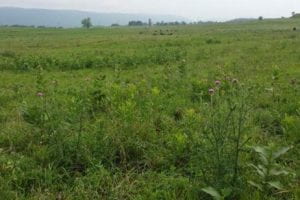– Justin Brackenrich, PA Extension Educator, Field and Forage Crops and Jessica A. Williamson, Ph.D., PA Extension Forage Specialist

A field with many noxious weeds, including Canada Thistle and Milkweed which would be undesirable to a hay producer. Photo Credit: Jessica Williamson, Penn State Extension
Much like 2018, the unpredictable weather of 2019 has led to later and more “between rain” cuttings of hay in Pennsylvania. The biggest concerns of this unpredictable cutting schedule are reduced forage quality, damage to fields due to wet conditions, and the encroachment and establishment of weeds. Reducing forage quality due to late cutting is always concerning, and muddy meadows are not something pleasurable to deal with, but the management of weeds, especially when we consider their potential to contain toxins, can quickly become a producer’s biggest nightmare.
In the spring of the year, that small patch of milkweed, or those few stalks of hemlock that were on the wood line, may have now developed into a thriving stand that has spread into your hay field. What do you do? What is the best answer for managing for weeds? What to do with the hay that has been infested with poison weeds?
The first thing to consider is the species of weed that you are dealing with and the amount of weed that the animal must ingest before it becomes an issue. As an example, a 1,200-pound cow could exhibit toxicity symptom after eating as little as a pound of a Nightshade species but could take up to 120 berries of the Common Poke Weed plant to exhibit symptoms. These are not “rules” for managing and feeding cattle forages with poisonous weeds, but rather just an expression of how different plants will have different levels of toxicities. More information on symptoms, toxic ingredient, and dosage can be found in the article Spring Hay and Pasture Weed Issues . This article also discusses options for herbicide and cultural management practices for these weeds.
When dealing with hemlock or nightshade weeds, the only option is to spray or remove the weeds by hand (wearing the proper PPE) and control the issue. Other weeds like milkweed and pokeberry, can be dealt with on a more cultural level and present a lessened threat to your livestock. If you are dealing with annual grasses, such as Giant Foxtail, the return to a regular mowing schedule or the use of an herbicide can help eliminate these species.
If you have hay from a field that has weeds you know or believe to be poisonous, the first thing to do is to keep that hay separated from the rest of your supply. Once it is mixed with the rest of your feed, it will be impossible to separate. There isn’t only the concern of feeding the weed to your livestock, but also introducing that seed into a new area of your operation through feeding or manure. Next, call your local Penn State Agronomy Educator and discuss your options for weed control and the best strategies for feeding that forage.